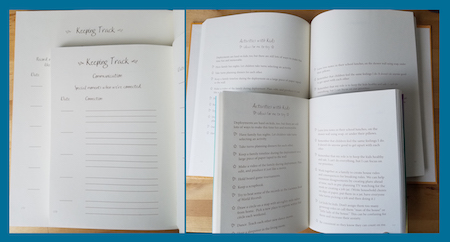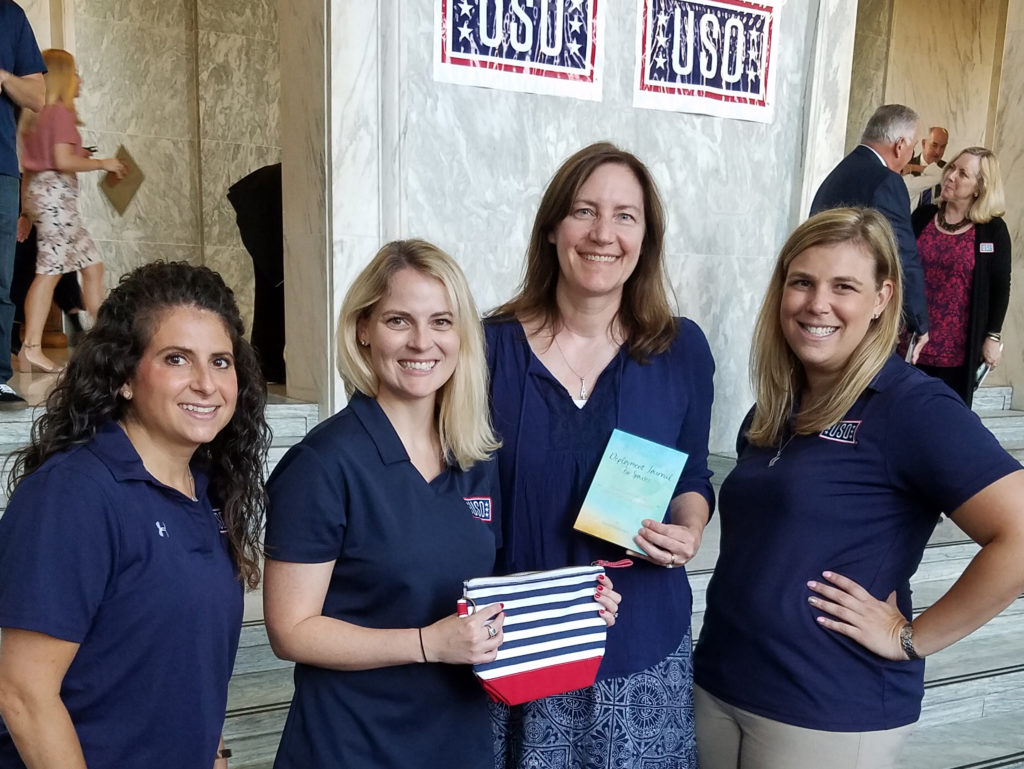PUBLISHED MAY/JUNE 2019
by
Karen Pavlicin-Fragnito, Publisher,
Elva Resa Publishing --

Karen Pavlicin-Fragnito
Overcoming content alterations, design/format constraints, a tight timeline, and a limited budget to meet the goals of a publishing partner.
Elva Resa Publishing is a traditional indie publisher specializing in books for military families. While we participate in traditional distribution, more than 75 percent of our business is bulk sales to government, education, and nonprofit organizations supporting military families. Maintaining partnerships with key organizations is critical to our success in reaching our end readers who live a highly mobile life.
One way we work with our partners is to create custom editions of our core resources. A recent example is our work with the United Services Organizations (USO). In 2018, the USO launched a pilot program to distribute care packages to military spouses of service members deployed to specific remote locations. The USO team wanted to include a copy of Elva Resa Publishing's popular
Deployment Journal for Spouses by Rachel Robertson.
 Elva Resa created a custom edition of its
Elva Resa created a custom edition of its Deployment Journal for Spouses
for a USO military spouse care package program. The project involved a custom cover, minor editorial changes, and altered trim size to fit in the USO pouch with other care package items.
To meet the USO's goals, we had to address four challenges: minor content alterations, design/format constraints, a tight timeline, and a limited budget.
The first challenge was easily resolved with minor changes to a few journal prompts and inspirational quotes.
The second challenge required alterations to the trim size and format. The original retail version of the journal was too large for the custom care package pouches. To fit in the pouch alongside other items, the journal needed to be 5 inches by 7 inches, instead of the retail trim size of 7-1/8 inches by 9-1/4 inches. To reduce confusion between the retail and USO versions, we created a custom cover design, replacing the sewn Pellaq hardcover material with a four-color printed softcover, layflat binding, and French flaps. We agreed on nonreturnable terms; since the books were not for resale, we did not include a barcode in the new design. Instead, we added a custom message and cobranded the book to clearly indicate the journal was published by Elva Resa for the USO.
The timeline was tight, with approximately six weeks to make design/format changes, print books, and get them shipped in time for a stuffing event on Capitol Hill. In spite of a busy season, Cushing-Malloy was able to guarantee our delivery date while meeting our budget constraints. Customer service representative Adam Hieber collaborated with us on the creative solution of French flaps to make the journal feel unique and provide added stability inside the pouch.
Our fourth challenge was budget. The USO pilot program solidly matched Elva Resa's goal to support military spouses during deployment and gave us an opportunity to introduce our resources to more military families. Profit was a lesser priority than aligning our missions and supporting the USO's military spouse program. A successful pilot could evolve into a larger, longer-term program. Working with our printer, our team priced the project based on our costs so we could meet the USO's budget constraints for the initial print run of 2,000 journals.
Considerations for Custom Editions
For publishers of all sizes, repurposing content to create custom products can further your mission, increase revenue, extend marketing reach, and provide opportunities for growth.
Corporate and nonprofit organizations consider custom editions for clients, employees, shareholders, or primary constituents served under the organization's mission.
When cobranding or creating a custom edition, the business deal should support your publishing company's mission, meet defined goals, integrate into your team resource plan and budget similar to other projects, and positively impact your existing business model.
Evaluate the Opportunity
Just as you evaluate potential manuscripts to see if they fit with your publishing company's mission, your team's expertise, and your niche portfolio, it's important to develop a similar process for evaluating opportunities for custom products. Not all special sales or custom edition opportunities are practical, especially if they take critical resources-people, time, money-away from higher-priority books. Before you accept a custom edition project, be clear about why you want to pursue it.
Mission
- Does this customer/partner's mission align with or complement yours? Does the organization serve a similar audience? Does this custom edition have potential to extend your mission or message in a meaningful way?
- Why is this organization choosing your publishing company for this custom product? Is it primarily related to your mission, the book's content, your past products, or a desire to develop long-term partnership?
Goals-Primary Focus
- A successful project means both the publisher and partnering organization meet their respective goals.
- What do you expect to achieve as a result of this opportunity? Define the primary focus: revenue, mission, market reach, or portfolio extension. What metrics will you measure?
- What is the customer/partner's primary goal with this project?
Legal
- Reread the author's contract. Are there restrictions or obligations associated with a custom edition? Any special royalty requirements?
- Honor copyright and trademark notices or filings as necessary.
Investment/ROI
- Assess your required investment (use the project planning tips below). Do you have the resources-people, time, cash-for this project?
- What is the bottom-line result financially?
- Is this a one-time order? Is there synergy for other opportunities in the future? Is this repeatable with similar products or organizations?
- Talk with your author and publishing team about the above evaluation. Is everyone on the same page with goals, effort, investment involved, and anticipated return on investment?
 With a tight timeline, the team decided to keep the overall content, fonts, and interior layout the same, creating the same journal in a reduced trim size to fit the USO packaging.
With a tight timeline, the team decided to keep the overall content, fonts, and interior layout the same, creating the same journal in a reduced trim size to fit the USO packaging.Plan the Project
Don't be fooled into thinking a custom edition does not need the same attention to detail as a new book. While you may have already created the content, you will still need to define and confirm the editorial, design, production, and operational details for the custom edition.
Editorial
- Will the content be the same or similar to an existing book, or will new content need to be written, researched, updated, or fact-checked?
- Has the customer/partner read the content and accepted it with agreed-upon changes? Are any special approvals necessary?
Format and Design
- Will the custom edition have the same trim size, fonts, and layout as a previous commercial edition?
- Will you add a wrap over the existing cover or create a custom cover for this project?
- Do you need to incorporate a special message or logo into the design?
Cobranding
- Will your company imprint remain on the product?
- Do you have any concerns about your customer/partner's reputation being associated with your brand? Any increased liabilities?
Inventory
- Are you using existing inventory or printing a special press run?
- What is the minimum order quantity to make the project worthwhile? Consider your time/focus as well as the per-book COGS at the minimum quantity.
- Consider time constraints for delivery of the custom edition. Can your printer and warehouse meet the timeline?
Pricing
- Does this project fall under a standard discount structure for bulk sales (price based on percentage of retail)? Or is this a mutually beneficial marketing or mission-based program (price based on cost)?
- When figuring your costs, be sure to include cost of development (e.g., editorial, design, production, prepress), printing (with quantity minimums), author royalties, permissions/licenses, taxes, shipping, and other project-specific costs.
Terms
- Common custom-edition payment terms include prepayment or 50 percent with order/ balance on delivery. You may honor existing payment terms with regular customers.
- All custom editions should be sold to your customer/partner on nonreturnable basis. If your customer will give the book as a gift or use in a special program, do not include a barcode.
- If your customer intends to resell the book, be sure return information is printed with the barcode and on the copyright page so returns go back to your customer, not you. If you are including a wrap or sticker on existing inventory with a barcode already printed, invalidate the barcode to reduce returns. Unfortunately, some recipients of free books try to return them to a bookstore. Your goal is to reduce that risk.
- Discuss other special terms. For example, do you have permission to promote this project with other potential customers?
Assess the Results
After implementation, circle back with your customer/partner to assess the custom edition project. Did it meet the goals? What adjustments would you make for future projects?
[caption id="attachment_39261" align="alignright" width="300"]
 Publisher Karen Pavlicin-Fragnito (second from right) attended the USO's "Assemble Care Packages" event on Capitol Hill to see Elva Resa's partner in action, talk in person with the USO team, and generate ideas for other ways the organizations can support each other and achieve their mutual goal of supporting military families.
Publisher Karen Pavlicin-Fragnito (second from right) attended the USO's "Assemble Care Packages" event on Capitol Hill to see Elva Resa's partner in action, talk in person with the USO team, and generate ideas for other ways the organizations can support each other and achieve their mutual goal of supporting military families. How does your team feel about the project? If custom editions are an opportunity you want to pursue regularly, make a short list of potential customers, partners, or projects to incorporate into your planning.
Custom editions, when carefully selected and managed to complement your mission and portfolio and to reduce negative disruptions to normal operations, can open doors to meaningful partnerships, effective niche marketing opportunities, and alternate revenue streams. Publishers with successful custom edition projects may find it worthwhile to promote the capability and add resources focused on custom editions as a regular offering.